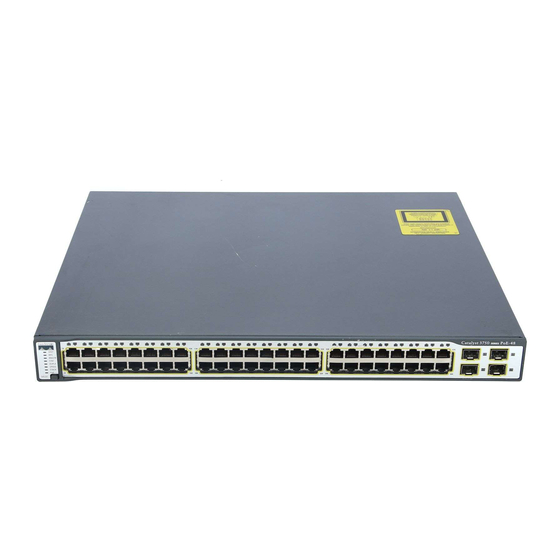
Cisco WS-C3750-48PS-S Manuals
Manuals and User Guides for Cisco WS-C3750-48PS-S. We have 1 Cisco WS-C3750-48PS-S manual available for free PDF download: Software Configuration Manual
Cisco WS-C3750-48PS-S Software Configuration Manual (1010 pages)
Network Switch
Table of Contents
-
-
Features42
-
-
-
Online Help79
-
-
Guide Mode79
-
Expert Mode80
-
-
Wizards80
-
-
CMS Icons90
-
-
Booting Manually
103
-
-
-
IP Addresses
141 -
Host Names
141 -
Passwords
142 -
LRE Profiles
145
-
-
Configuring NTP156
-
-
-
-
-
RADIUS Operation205
-
-
-
-
Device Roles230
-
Accounting233
-
-
-
-
-
Supported Vlans287
-
Token Ring Vlans
290 -
Deleting a VLAN
295-
-
Displaying Vlans300
-
Configuring VMPS311
-
Configuring VTP319
-
-
-
The VTP Domain320
-
VTP Modes321
-
VTP Version 2322
-
VTP Pruning323
-
Configuring VTP324
-
-
Domain Names326
-
Passwords327
-
VTP Version327
-
-
Monitoring VTP334
-
-
-
Step 1
348 -
-
Configuring STP357
-
-
STP Overview358
-
-
Blocking State363
-
Listening State363
-
Learning State363
-
Forwarding State363
-
Disabled State364
-
-
-
-
Configuring MSTP381
-
-
-
-
-
-
-
IGMP Versions466
-
Immediate Leave469
-
Configuring MVR479
-
-
-
Configuring CDP
507 -
-
Local SPAN522
-
Remote SPAN523
-
-
SPAN Sessions524
-
Source Ports526
-
Source Vlans527
-
VLAN Filtering527
-
Destination Port528
-
Rspan Vlan529
-
-
-
-
Configuring RMON
545 -
-
-
Configuring SNMP565
-
-
SNMP Versions566
-
Configuring SNMP570
-
SNMP Examples580
-
-
-
-
-
Numbered Acls606
-
Extended Acls606
-
Named Acls606
-
ACL Logging608
-
-
Configuring Qos
625 -
-
Basic Qos Model627
-
Classification628
-
Mapping Tables634
-
-
-
-
-
-
-
Configuring RIP736
-
Configuring OSPF741
-
Configuring BGP756
-
-
Configuring HSRP791
-
-
Configuring HSRP793
-
Enabling HSRP794
-
-
-
-
IGMP Version 1805
-
IGMP Version 2805
-
PIM Versions806
-
PIM Modes806
-
Auto-RP807
-
Bootstrap Router807
-
-
-
-
-
-
Configuring MSDP855
-
-
MSDP Operation856
-
MSDP Benefits857
-
Configuring MSDP858
-
-
-
-
Troubleshooting887
-
-
Using Ping900
-
Executing Ping901
-
Using TDR
905 -
Appendix
913 -
Supported Mibs
913-
MIB List913
-
-
Appendix
917 -
-
-
Copying Files921
-
Deleting Files921
-
-
-
-
Appendix
951 -
-
ARP Commands952
-
Hsrp
954-
Miscellaneous959
-
Msdp
959 -
Radius
960 -
Snmp
961 -
Vlan
961 -
Vtp
961 -
I N D E X
963
Advertisement
